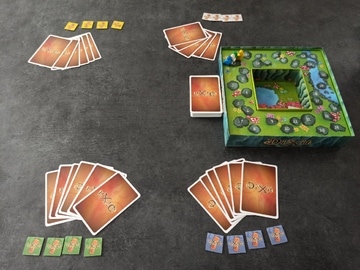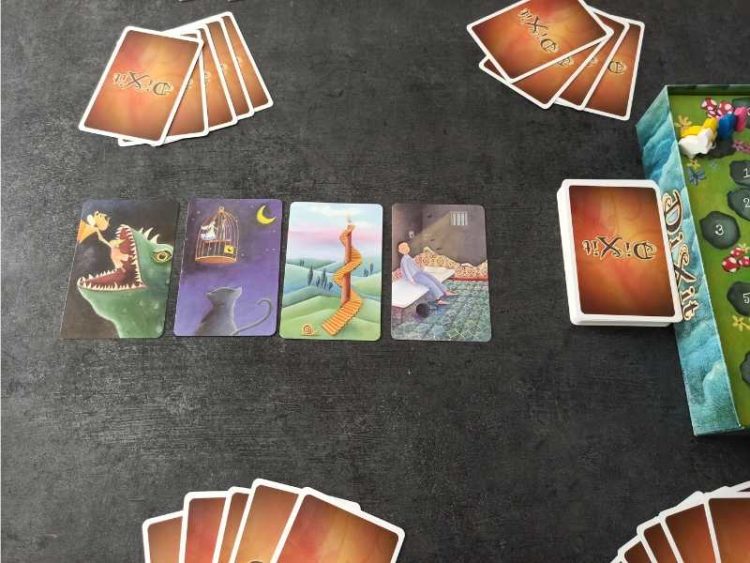
OBJECTIVE OF DIXIT: The objective of Dixit is to guess and make guess cards with beautiful drawings.
NUMBER OF PLAYERS: 3 to 6
MATERIALS: An indoor game board (scoring track), 6 wooden “rabbit” counters, 84 cards, 36 “voting” tokens of 6 different colours numbered from 1 to 6
TYPE OF GAME: Guessing game
AUDIENCE: Any age
OVERVIEW OF DIXIT
In Dixit, one picture is worth a thousand words. Each player has in turn to choose one of his cards and make it guess with only one sentence. But his card will be shuffled with one other card of each player to make things a bit more challenging.
SETUP
Each player chooses a rabbit and places it on the 0 square of the score track. The 84 pictures are shuffled and 6 are distributed to each player. The rest of the pictures constitute the draw pile. Then each player takes voting tokens according to the number of players (with the corresponding values). For instance, in a game with 5 players, each player takes 5 voting tokens (1 to 5).

GAMEPLAY
The Storyteller
One of the players is the storyteller for the round. He examines the 6 pictures he has in his hand. From one of them he works out a sentence and says it out loud (without revealing his card to the other players). The sentence can take different forms: it can consist of one or more words or even be summed up as an onomatopoeia. It can be invented or take the form of already existing works (excerpt from a poem or song, film title or other, proverb, etc.).
Designation of the first storyteller of the game
The first player who has found a phrase announces to the others that he is the storyteller for the first round of the game. The other players select from their 6 pictures the one that they think best illustrates the sentence spoken by the storyteller. Each player then gives the storyteller the picture they have chosen, without showing it to the other players. The storyteller mixes the pictures collected with his own. He places them randomly face up on the table. The card furthest to the left will be card 1, then card 2, and so on…

Finding the picture of the storyteller
The vote
The goal for the players is to find the picture of the storyteller among all the exposed pictures. Each player votes in secret for the picture he thinks is the storyteller’s (the storyteller does not participate). To do this, he puts the voting token corresponding to the chosen picture face down in front of him. When everyone has voted, votes are revealed. They are placed on the pictures they point to. This is the moment for the storyteller to reveal what his picture was. Beware: under no circumstances can you vote for your own picture!
Scoring
- If all the players find the storyteller’s picture, or if none of them find it, the storyteller does not score any points, all other players score 2 points.
- In other cases, the storyteller scores 3 points as well as the players who find his picture.
- Each player, except the storyteller, scores 1 additional point for each vote collected on his picture.
Players advance their rabbit token on the score track by as many squares as they have earned points.

- The storyteller (green player) scores 3 points as one player (yellow) found his picture
- The yellow player found it and his picture was the fourth one, so he scores 3 points plus 1 point thanks to the blue player
- The blue player scores one point thanks to the white player
- The white player scores no point
End of round
Each player completes his hand with 6 pictures. The new storyteller is the player to the left of the previous one (and so on in a clockwise direction for the other rounds).
END OF GAME
The game ends when the last card of the draw pile is drawn, or when a player reaches the end of the scoring track. The player with the most points at the end of the game is the winner.
Enjoy!
TIPS
If the storyteller’s sentence describes his picture too precisely, all players will find it easily and in this case he will not score a point. On the other hand, if his sentence has little to do with his picture, it is likely that no player will vote for his card, and in this case he will score no points! The challenge for the storyteller is therefore to invent a sentence that is neither too descriptive nor too abstract, so that there is a chance that only a few players will find his picture. At the beginning it may not be easy, but you will see that inspiration comes more easily after a few rounds of the game!
VARIATIONS
3-player game: Players have seven cards in hand instead of six. The players (except the storyteller) each give two pictures (instead of one). There are 5 pictures on display, the storyteller’s picture must always be found among them. Counting: When only one player finds the storyteller’s picture, both score four points instead of three.
Mimes or Songs: in this variant, instead of saying a sentence, the storyteller has the possibility to hum a song or music inspired by the picture, or to make a mime, in connection with the picture. The other players, as for the sentence, search in their game for the picture that this tune or mime evokes to them, and will then try to find the storyteller’s card. The count does not change.
- 12 BEST HARRY POTTER BOARD GAMES - November 16, 2023
- 50 BEST HALLOWEEN GAMES - October 4, 2023
- 50 BEST CHRISTMAS GAMES - September 13, 2023